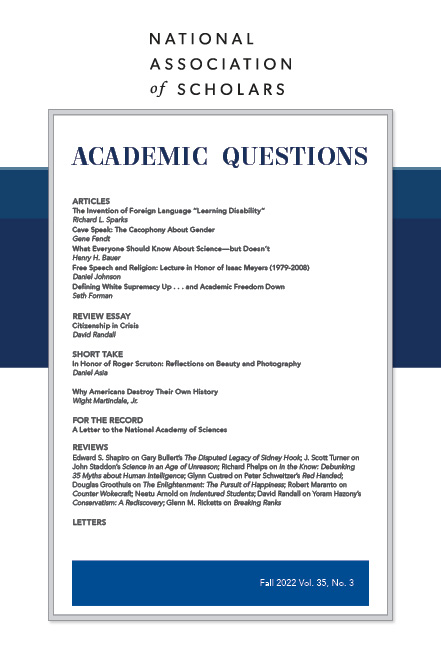Conservatism: A Rediscovery, Yoram Hazony, Regnery Gateway, 2022, pp. xxix + 445, $29.99 hardcover.
David Randall is director of research at the National Association of Scholars, 420 Madison Ave., 7th Floor, New York, NY 10017; [email protected]. His most recent books are The Concept of Conversation: From Cicero’s Sermo to the Grand Siècle’s Conversation (2018) and The Conversational Enlightenment: The Reconception of Rhetoric in Eighteenth-Century Thought (2019). Randall last appeared in AQ with “A Plagiarism Schematic” (Fall 2021).
Yoram Hazony’s Conservatism: A Rediscovery aims to provide a useful primer on conservatism, to aid in a conservative revival in America today—a necessary revival, in an America whose elites and institutions largely have succumbed to a variety of Marxism that substitutes race and gender for class. Hazony’s book is one of a slew of new works attempting to chart a course for the fractured post-Trumpian conservative movement. By implication, Conservatism also speaks to education reform, for the ideal republic is an imperfect mirror of the ideal university. Hazony’s work consists partly of a history of Anglo-American conservatism; partly of his reformulation of conservative principles; partly a review of recent events to situate how we got into our current predicament; and, briefly, a memoir that individualizes and gives flesh to his conservative principles, by way of exemplifying how to live a conservative life. While Hazony makes the case that he has articulated a viable conservative philosophy, he is less persuasive in arguing that it is the conservative philosophy America needs in 2022.
Hazony’s intellectual history of Anglo-American conservatism provides a lineage leading by way of English constitutionalism and the Anglican prayer book to a Hamiltonian rendition of the American republic. Hazony summarizes the principles of Anglo-American conservatism as historical empiricism, nationalism, religion, limited executive power, and individual freedoms. His English tradition begins with common law and the unwritten constitution, invoking the iconic figures of the late medieval John Fortescue and the early modern John Selden. Hazony then summons up in Richard Hooker the moderate spirit of the Church of England that cherishes custom more than Puritan zeal, and in Edmund Burke the enduring conservative riposte to liberalism.
Hazony turns next to an American conservatism defined by Hamiltonian Federalists. The Federalists emphasized the American continuity with the British constitutional past, as fact and ideal; championed economic and immigration policies devoted to the national interest; and preferred a friendly alignment between Christianity and the new republic, rather than the Jeffersonian belief that good fences make good neighbors. In policy, notably, the constitutional and religious Federalists of the North, not their liberal and freethinking opponents of the South, became the early champions of the abolition of slavery. Hazony takes the Federalist inheritance of the English conservative tradition to be both the intellectual means for preserving America and the heart of the American political inheritance worth preserving.
Hazony’s own conservative philosophy, conceived of as a contribution to this Anglo-American and Federalist tradition, essentially updates Russell Kirk—but, in riposte to the woke campaign for coercive egalitarianism and “individuality,” puts greater emphasis on hierarchy, family, nation, and religion. Hazony argues with particular eloquence that conservative support for hierarchy is a natural and good state of human affairs—that we are born into societies whose members possess different capacities, and that from birth we rightly honor with authority men with superior experience and talents. Against the egalitarian individualism that uses the power of the state to tear apart the family and society, Hazony argues for the rightful power and authority of the family and the nation. The nation, that extended family of shared history, institutions, custom, and affection, likewise should command our allegiance and must undergird the state. Hazony’s final emphasis is religion—more generally the religion of God and Scripture, and (by implication from his book’s tenor) more particularly the spirit of Anglicanism and Modern (Jewish) Orthodoxy, which make religious practice a habit and incorporate the individual and the family into a faith community.
Hazony takes the rationalizing liberal paradigm to be acid to all these conservative a prioris—that the naked and uncompromising commitments to individual freedom in the political, economic, and social spheres delegitimize, and must dissolve, hierarchy, the family, the nation, and religion. Ultimately they must dissolve all solidarity and natural sympathy as they work to create a world of free, but loveless, human atoms.
Hazony’s review of modern American conservatism takes in both the formation of its postwar consensus and the current neo-Marxist challenge presented by the woke. In his sketch of the rise of post-World War II conservatism, Hazony acknowledges the short-term political effectiveness of the Fusionist impulse, particularly fostered at National Review. He also allows that “the liberty of the individual is a fine thing . . . when taken in the right proportion.” (xviii) But Hazony also emphasizes the long-term weakness that resulted from incorporating the Hayekian and Straussian schools of liberalism into a putatively conservative movement: “liberalism is an ideology that promises to liberate us from precisely one thing, and that thing is conservatism. . . . To the extent that Anglo-American conservatism has become confused with liberalism, it has, for just this reason, become incapable of conserving anything at all.” (xvii-xviii) The conservative movement’s internal compromise underwrote a long-term subservience to liberal intellectual hegemony.
This was bad enough in itself, but liberalism’s own intellectual weaknesses made it unable to resist a constant surrender toward Marxist radicalism. The declaration that the world should be entirely free and equal slipped easily to a determination that no individual or institution that opposed this goal had moral or political legitimacy. The world must be liberated from the oppression that denied it its natural perfection, and made free and equal—by any means necessary. An unconservative conservatism’s acquiescence to liberalism thus became acquiescence to Marxism.
Hazony’s own vision of a refurbished conservative democracy provides a programmatic sketch of the principles he has previously adumbrated. Most practically, free-marketeers would take a backseat in this rejiggered conservative coalition—as would Straussians.
Hazony concludes with a personal account of his life, and what his brand of conservatism has brought him. In his case, he and his ex-Presbyterian wife found, from family backgrounds broken in different ways, a fulfilling variation of the American dream in Princeton conservatism, Modern Orthodox Judaism, and eventual aliyah to Israel. He recommends, based upon his own experience, that all conservatives who preach conservative morality also practice it. “In the absence of a family and a congregation of one’s own, all this is, in the end, mere hypocrisy and vain words.” (391) Hazony seeks, more inspiringly than some before, to be, in the words of Robert Burns, “A guide, a buckler, and example, To a’ Thy flock.”
Hazony’s project leads him to discard an extraordinary amount of the Anglo-American liberal tradition. Snipped away are John Milton and the Glorious Revolution, John Locke on political liberty and Adam Smith on economic freedom, those rabble-rousers Thomas Jefferson and Thomas Paine, and even William Blackstone, that champion of common law who declared that “the principal aim of society is to protect individuals in the enjoyment of those absolute rights, which were vested in them by the immutable laws of nature.” Gone too is much of our religious inheritance—the Dissenting tradition of England and the Puritanism of America, the Enlightened evangelism of Jonathan Edwards, and (as essential to abolition as the Federalist strain) the uncompromising radical abolitionism of John Woolman, Frederick Douglass, and John Brown.
Hazony’s answer is that an attempt to save the inheritance of Locke and Jefferson will now entangle us in fatal compromise with the woke: “under the present conditions of permanent revolution and cultural devastation, the most important thing to remember about individual liberties is that, in and of themselves, they have no power to make anything stable or permanent.” (xviii) Hazony may be right. But if so, we have lost a great deal that made America, and that made America worth conserving.
Hazony’s admiring argument for hierarchy also fails to address the deep-rooted American allergy to the mores of deference. Gordon Wood’s Empire of Liberty elaborates just how enduringly important was the revolt against social deference in the Republic’s first generation—and that revolt possessed even deeper origins in the English history of Lollard rebellion, masterless men, and Quakers refusing to doff their hats to magistrates. The Trumpist rebellion, after all, is animated in part by a very American dislike of demand for social deference based on “expertise,” “education,” “anti-racist commitment,” and so on.
Hazony’s praise of the family likewise fails to take account of how distinctively English has been the weakness of our family bonds, for at least a thousand years—and, as a practical matter, it is difficult to know how to reassemble a tight family in a country where half the nation has lost even the memory that such families exist. Hazony’s praise of ritualizing religion also fails to take sufficient account of the suspicion of ritual and non-Scriptural authority central to (among others) our Baptist and evangelical traditions. Certainly these suspicions have weakened their ability to resist the woke revolution—and Hazony rightly says that more ritualizing religion might proffer a better response. But his recommendations seem more suited to a revived English Anglicanism than to America’s Dissenting mores.
Hazony’s arguments about what went wrong with the conservative movement and with liberalism are accurate and acute. He is persuasive about the need to subordinate free-marketeering to a broader nationalism conservatism. Yet his polite dismissal of the Straussians in his project seems a tactical slip, since they are the most intellectually effective body of critics of the dhimmi conservatives. I do not see how Hazony can succeed in his new Fusionism without the Straussians. And then, while Hazony’s brand of conservatism has served him well, I doubt it will appeal to a majority of Americans—or even a sufficiently influential elite. As Hazony himself acknowledges, “I often speak to young men and women who say they are excited about ‘conservatism.’ Yet when the sabbath comes around, they have not the slightest intention of keeping sabbath.” (392) But these are the conservatives we have. Must we not work from what they are, not what they should be?
As an inspiration for university reform, Hazony’s vision aligns with that of the National Association of Scholars. At any rate, “[t]he liberty of the individual is a fine thing . . . when taken in the right proportion” seems closer to the vision of Peter Wood’s The Architecture of Intellectual Freedom than it does to the principles of the Foundation for Individual Rights in Education.1 A Hazonyan college would be a fine model for a revived American academy.
But the conservative revival in the American republic must start on a broader intellectual base than the earnest combination of neo-Kirkian conservatism and faith in Anglican and Modern (Jewish) Orthodox accents that Hazony proffers. The doughtiest opponents of dhimmi conservativism include large numbers of philosophical liberals, whether Straussian or Smithian—and they are the heirs of the wonderful Anglo-American tradition of fiery orneriness that we need to make our counterrevolution. And our poor degraded America, whose nation now includes millions ignorant of family, religion, and any hierarchy save that of our depraved elites—I fear that Hazonyism will not attract them. The national project has to appeal to the liberalism and the irreverence that run so deep in the American character—and it must have something of the Salvation Army and of Chabad, to redeem the Americans brutalized by our radical establishment.
And it should have room for the smaller, needful joys of Anglo-American life, from Izaak Walton fishing to the Andrews Sisters singing. Hazony does not seem to have considered that American conservatism should cherish anything so frivolous as a long day by a riverbank with a pole. His doctrine is a touch dour for Americans.
America’s national conservatism needs James Brown and Madonna on the soundtrack. We won’t join the counterrevolution if we can’t dance.
1 FIRE has recently changed its name and its mission. It is now called Foundation for Individual Rights and Expression.













